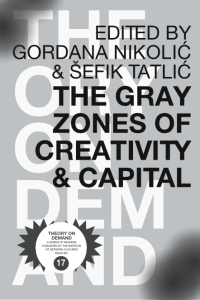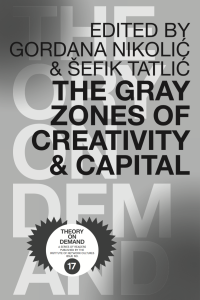While researching the challenges experienced in the hybrid publishing field, the issue of proprietary software and its limitations has cropped up from a few sources. So, I thought we could give Scribus (Open Source layout software) a test run using a chapter from the most recent Theory on Demand publication and see if it could be a viable alternative.
What is Scribus?
Scribus is publishing and professional layout software supporting EPS and SVG import/export, and PDF. Scribus was founded in 2001 and they say the main reason to use Scribus is that it is “Free with an uppercase F. It means that you are in control of your data and, if you wish, the code of your desktop publishing tool”. Their about page claims it is usable across many operating systems: Linux, FreeBSD, PC-BSD, NetBSD, OpenBSD, Solaris, OpenIndiana, Debian GNU/Hurd, Mac OS X, OS/2 Warp 4, eComStation, Haiku and Windows.
How does this work with the Digital Publishing Toolkit Workflow?
The markdown source file is the key component in the DPT Workflow, it is the file from which you can convert to html, ePub and icml. This works well because all changes get made in the source file which then updates the other outputs, removing repetition of editorial work. The PublishingLab currently relies on Adobe InDesign to create our printed publications. Usually, an icml file is imported into InDesign which can then be updated if any editorial changes are made after the design process has begun. The icml file didn’t import successfully to Scribus v1.5.0, so we imported the chapter as an html file instead.
What did we try to do with it?
As stated earlier, we took one chapter from a recently published book, and tried the following tasks in a 3hr block:
- replicate the front cover
- import 1 chapter of text + insert image with caption
- create and apply a master page
We kept the tasks simple because this was the first time either of us had used Scribus and the interface was totally new to us. This way we could evaluate whether these tasks were achievable in a short period of time, and what our first impressions of the interface were.
Cover designed in InDD CS5.5 & Scribus 1.5.0
Both covers used a Photoshop file for the shadow effect, but other than that were composed of an InDD or Scribus file with layers.
Typography
The challenges I encountered setting up this chapter were mainly typographic. The first dealt with attaching a caption to an image, the second involved adding special characters to the Cover title.
Anchoring or dynamic relative positioning is not yet supported in Scribus 1.5.0, which is a bit disappointing because changes made to the text would require manually updating the image positioning. Scribus allows you to create an ‘inline’ graphic, essentially cutting the image from the image frame and pasting it into the text frame in the right position, or alternatively, grouping text with an image – I haven’t tried this method yet.
Glyphs/special characters
Finding glyphs in Scribus was difficult. I resorted to getting the UTF code from InDD for 2 special charaters on the Title page (which is cheating because I was trying to achieve the same outcome without any reliance on InDesign). I first looked at the Scribus wiki on typography, but found the alternative was to search through an unicode index chart like this.
User Interface
There are challenges involved in learning anything new, but as we tested the interface, I couldn’t help but wonder if Scribus’ learning curve was unnecessarily steep. I tested Scribus version 1.5.0 together with another French graphic designer, both of us used to working with desktop publishing software. We both accessed the Scribus wiki to help us do relatively simple tasks.
My biggest criticism of Scribus is the user interface – it takes more steps than necessary to make changes. Something we’ve have taken for granted as both Word & InDesign users is that there would be a simple top bar which allows you to make changes directly to the text and see a real-time change. In order to do this in Scribus, you need to select the text frame, right click and select ‘preferences’ then make the changes in the preference panel. There isn’t a shortcut for this process, so it can feel unnecessarily tedious – taxing working memory.
Navigation hierarchies that are broad and shallow are easier for most people to find their way around in than narrow, deep hierarchies… This applies to menu hierarchies as well. (Johnson, 2007)
When comparing the experience of navigating the interfaces in order to make changes to the text appearance, you can see in the second comparison image that it took 4 steps using the edit text panel in Scribus, and just 2 in InDesign and Word (InDesign also allowed users to make this change in 2 places without opening new panels).
I agree with this review on Source Forge that the panels have clear usability problems: they don’t combine with other panels or collapse to allow for more space. As far as I know, Scribus deliberately kept their interface simple but I found this actually hinders quick text editing.
See interface comparisons below:
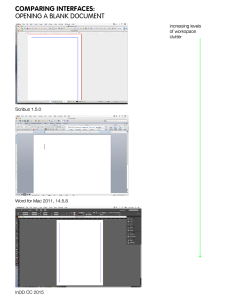
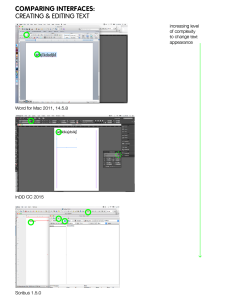
Formats
What formats can be opened by Scribus?
We tried a few file types from our workflow including docx, icml and html. An .idml (InDesign Markup Language) file did open correctly, but it required placing an .icml file in InDesign to generate it.
Below is a small table of formats that the Scribus Wiki says it currently supports and on the right are the formats we tried and frequently work with:
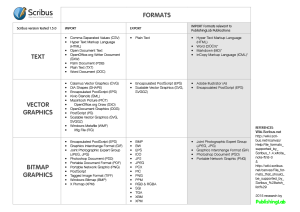
If you want to work with Scribus, there’s a wishlist for future supported formats that you can add to here.
Verdict
It is great that Scribus exists as a free, open source publishing software and we were able to create & apply a master page, closely replicate the cover design, and input text with a captioned image. However, the steep learning curve causes me to doubt that we will be able to implement it in the HPT Workflow soon.
Who else is doing things with Scribus?
Manufactura Independente
http://manufacturaindependente.org/
Libre Graphics
http://libregraphicsmag.com/
A more indepth UI analysis
https://docs.google.com/presentation/d/19TL-UUOFfrtya983eO1USOB9Cc9uqzOC51RtWMclIkA/edit#slide=id.g5f5f4645e_072
References
Bruce Byfield’s two helpful articles: http://www.linuxjournal.com/content/tweaking-text-scribus
http://www.linuxjournal.com/content/scribus-leading-kerning-and-tracking-text
Jeff Johnson, Designing with the Mind in Mind: Simple Guide to Understanding User Interface Design Guidelines, Waltham, MA: Morgan Kaufmann, 2014.



